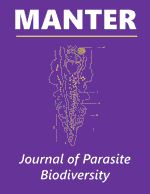Parasitology, Harold W. Manter Laboratory of
Date of this Version
3-24-2022
Document Type
Article
Citation
MANTER: Journal of Parasite Biodiversity, Occasional Papers, Number 18, May 24, 2022
doi: 10.32873/unl.dc.manter18
Abstract
Humans represent ecological super-spreaders in the dissemination and introduction of pathogens. These processes, consistent with the dynamics of the Stockholm paradigm, are exemplified in the origin and globalized distributions of SARS-CoV-2 since initial recognition in central Asia during 2019 and 2020. SARS-like viruses are not widespread in mammals but appear widespread in chiropterans. Bats are isolated ecologically from most other assemblages of mammals in terrestrial systems. Humans may be the stepping-stone hosts for broad global dissemination and wider infection (given the opportunity) among diverse assemblages of mammals in which host and viral capacity are compatible. Human globalization mediated insertion in global ecosystems along primary and secondary pathways initially with localized to regional circulation across continents. Origins and persistence of cycles involving variants and viral transmission among other mammals and the potential for secondary exposure (retrocolonization) of people occurs on multidirectional pathways. Humans were responsible for the initial breakdown in ecological isolation of the virus that facilitated colonization events from chiropterans to other mammals. In the absence of these human drivers, environmental or ecological interfaces (boundary zones among habitats) limiting the distribution of SARS-CoV-2 are unlikely to have been crossed, leaving a diverse assemblage of SARS-like viruses (Sarbecovirus) remaining relatively hidden and isolated in southeast Asia.
Included in
Biodiversity Commons, Disorders of Environmental Origin Commons, Environmental Public Health Commons, Parasitology Commons, Virus Diseases Commons, Zoology Commons


Comments
Copyright © 2022 Eric P. Hoberg, Walter A. Boeger, Daniel R. Brooks, Valeria Trivellone, and Salvatore J. Agosta
License: Creative Commons Attribution-NonCommercial-ShareAlike 4.0 International